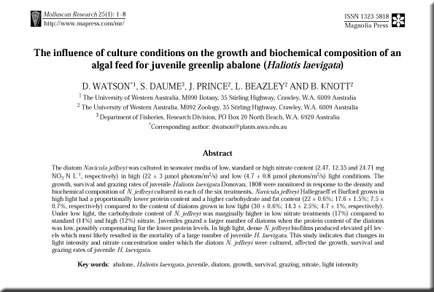Abstract
The diatom Navicula jeffreyi was cultured in seawater media of low, standard or high nitrate content (2.47, 12.35 and 24.71 mg NO3-N L-1, respectively) in high (22 ± 3 mol photons/m2/s) and low (4.7 ± 0.8 mol photons/m2/s) light conditions. The growth, survival and grazing rates of juvenile Haliotis laevigata Donovan, 1808 were monitored in response to the density and biochemical composition of N. jeffreyi cultured in each of the six treatments. Navicula jeffreyi Hallegraeff et Burford grown in high light had a proportionally lower protein content and a higher carbohydrate and fat content (22 ± 0.6%; 17.6 ± 1.5%; 7.5 ± 0.7%, respectively) compared to the content of diatoms grown in low light (30 ± 0.6%; 14.3 ± 2.5%; 4.7 ± 1%, respectively). Under low light, the carbohydrate content of N. jeffreyi was marginally higher in low nitrate treatments (17%) compared to standard (14%) and high (12%) nitrate. Juveniles grazed a larger number of diatoms when the protein content of the diatoms was low, possibly compensating for the lower protein levels. In high light, dense N. jeffreyi biofilms produced elevated pH levels which most likely resulted in the mortality of a large number of juvenile H. laevigata. This study indicates that changes in light intensity and nitrate concentration under which the diatom N. jeffreyi were cultured, affected the growth, survival and grazing rates of juvenile H. laevigata.

